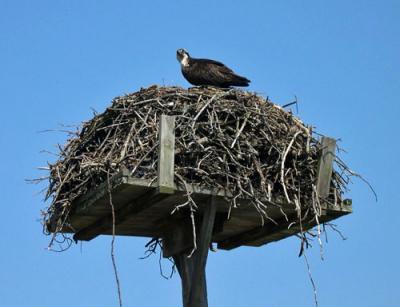
When you think about it, the whole Cape Cod ecosystem revolves around migration. I was reminded of this today, when I read about the return of the first ospreys to the Cape. This event signals the start of the annual Cape Cod migration.
The ospreys come to Cape Cod to raise their young in our environment rich with abundant food. As you see these majestic fish hawks soaring above the Cape, it is hard to believe that they were almost extinct just a few short years ago.
Visit the Cape Cod Museum of Natural History website and click on the osprey cam to view these beautiful creatures in their nest.
Not far behind the ospreys, are the herring, returning to ascend the creeks of the Cape to spawn.
It is an incredible journey of epic proportions.
Schools of herring traveling thousands of miles across the open ocean, escaping becoming a meal many times along the way in order to return to the exact place that they were born.
They will lay their eggs in the nutrient rich waters and then make their way back to the ocean.
If you are visiting the Cape during April, don’t miss this natural wonder. You can view the herring making their run upstream in Brewster at the Stony Brook herring run, at the Bournedale herring run along the Cape Cod Canal, at the Bell’s Neck Conservation Area in Harwich, and at the Mashpee River herring run in Mashpee.
Stony Brook is the only natural herring run, the other three are man made herring runs.
Researchers have noticed a severe decline in the number of herring returning to spawn in recent years.
As a result, there is a moratorium on the taking of herring or alewives in the Commonwealth of Massachusetts until further notice.
Let us hope that the story of the herring follows that of the osprey and the numbers of these incredible fish return to their former glory days.
Once the herring return, the striped bass is not far behind.
This amazing gamefish has itself faced adversity, and thanks to the efforts of fisheries managers across the east coast, the striped bass has made an incredible comeback.
The stripers migrate to the Cape in order to take advantage of the abundance of nutrient rich food available in Cape waters.
A large part of the striper’s diet is the herring.
Could it be that the incredible success of the striped bass has resulted in a marked decline in the number of herring?
If you catch stripers during your visits to the Cape, be sure to release most of them so that our children can enjoy the resource the way we enjoy it today.
There are many other species which migrate to the Cape. From songbirds and shorebirds to whales and seals…And oh yes…Sharks.
But perhaps the largest migration that occurs on Cape Cod happens for the same reasons.
The nutrient rich waters, the abundant food, the mild climate, yes, I am talking about the Cape Cod tourist migration.
Usually occurring around the end of May, although a few members of the species will arrive earlier, they will begin to inhabit the beaches and restaurants of the Cape.
For a while in mid-summer, Cape Cod will be thick with them.
They will begin migrating off of the Cape towards the end of the summer, although some will stay into the fall, and even a few lost souls will never find their way off Cape.
I hope to become one of those “lost souls”.
